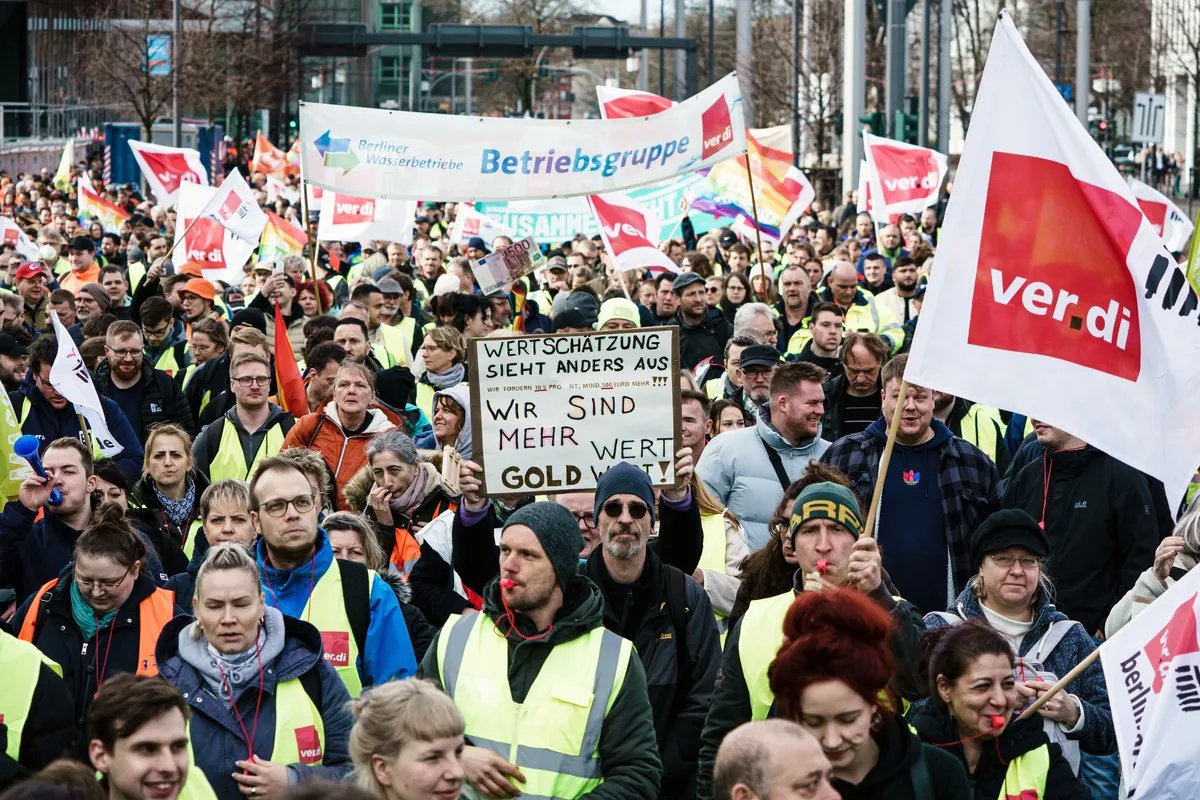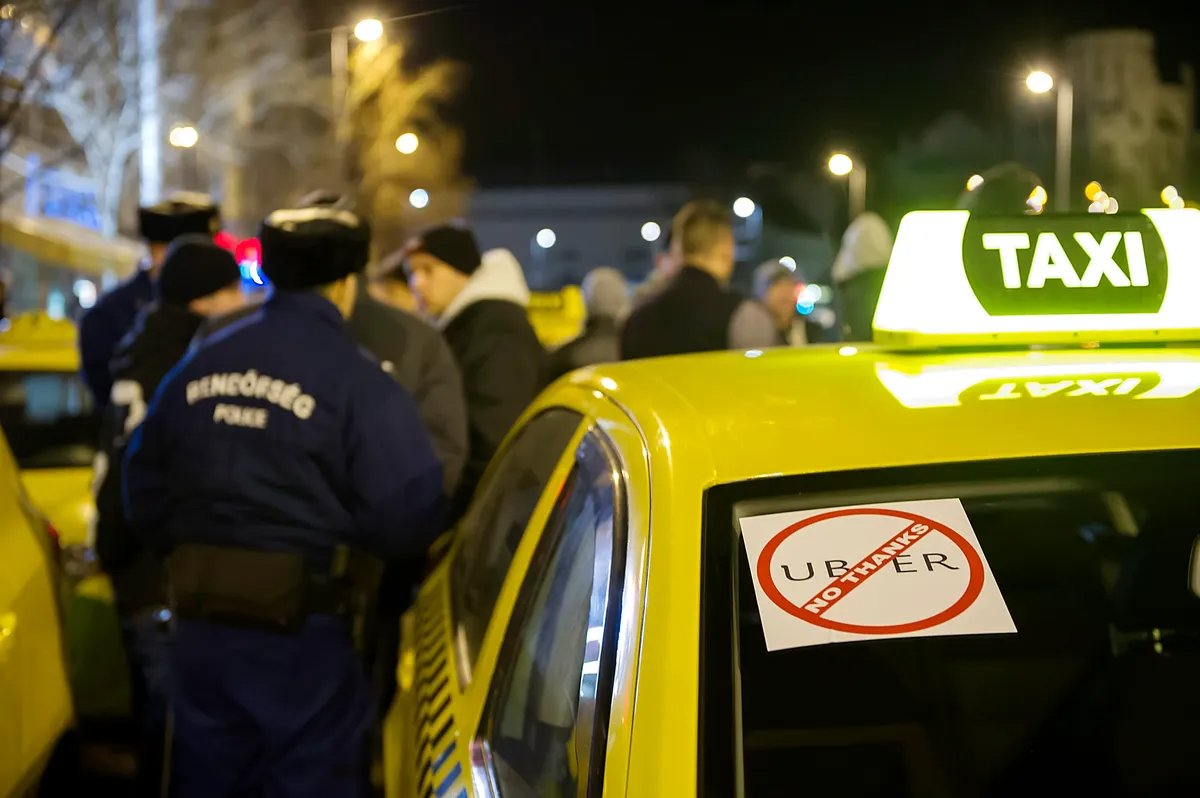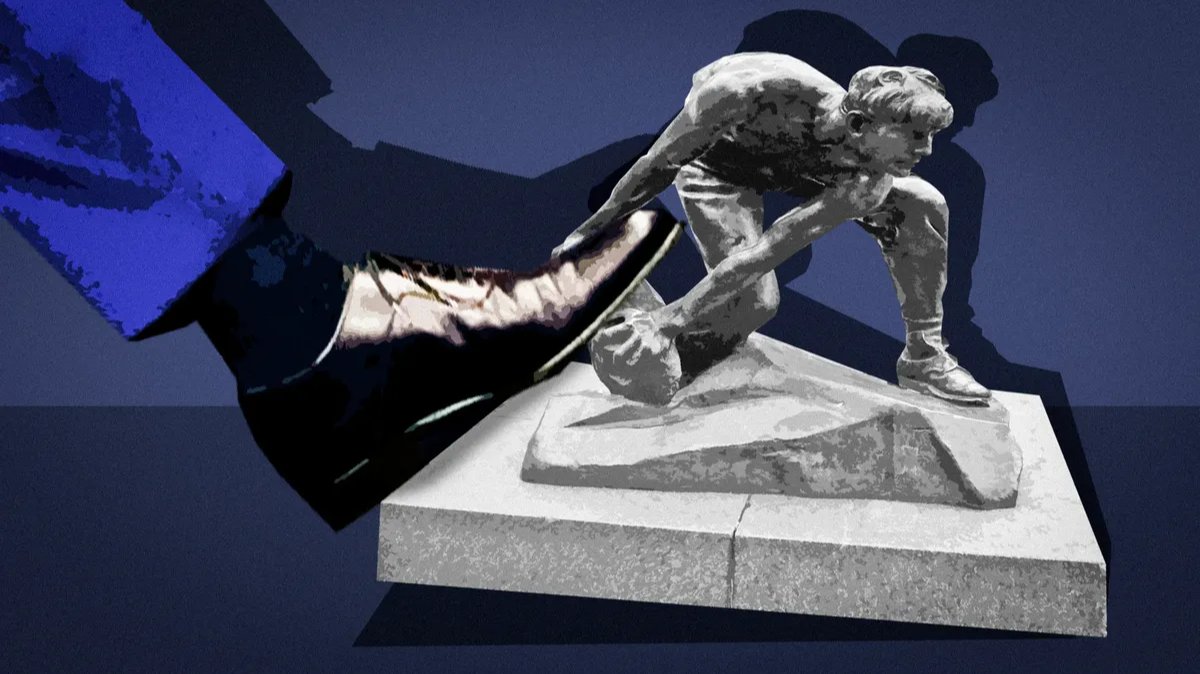Last weekend, viral videos from France showed ordinary people eating lunch and relaxing in cafes, ignoring the fires burning right next to them and other signs of protesters’ month-long fight with the police over the pension reform.
In Russia, March has also been marked by workers’ struggle for their rights. The strike of online retailer Wildberries employees, which covered several dozen regions, has already become one of the largest labour solidarity actions in recent years. But while such events come unexpectedly for Russia, the struggle for labour rights and the enhanced role of trade unions are part of the permanent political process in Europe. This is true not only in France, which is used to constant protests and strikes.
Political expert Denis Leven examines how trade unions work in European countries, and why, despite some clear success stories, the trade union movement in the EU today is clearly not at its peak.
On 15 March, Wildberries employees went on strike in Russia. The employees demanded a revision of the system of fines, procedures for returning defective goods, and overtime accounting. Wildberries initially denied the strike, but later decided to meet some of the protesters’ demands: the latest fines were cancelled and the system of wage deductions was frozen.
The scandal even reached the Russian State Duma (lower house), where a trilateral meeting was held on 17 March: it was attended by representatives of the company, MPs and private entrepreneurs — partners who own order pickup offices and participants of the Wildberries franchise. Meanwhile, members of the employee initiative group were not allowed at the meeting. Due to this, the trade union Employees’ Truth believes that concessions were made only to return the employees to their places of work. The union now intends to use new pressure methods on the company.
But even this result was one of the few successes of the trade union movement in Russia. The overwhelming majority of collective professional solidarity practices in the country are unpromising and dangerous. It would suffice to recall the persecution of the Courier trade union member Kirill Ukraintsev, who was sentenced to a real prison term for “violating public assembly rules”.
We could also mention the fate of Anton Orlov, coordinator of the Action medical union, who was sentenced to 6 years and 3 months in prison on what seems to be a trumped-up case of large-scale fraud.
Big difference
Things are different in European countries: here, trade unions and other forms of collective professional solidarity traditionally occupy an important place in public and political life both at the national and EU levels.
For example, in Scandinavian social democracy states, union membership is a natural part of social life. Unions are embedded directly in the management of employing companies and in national politics, through historical links with social democratic and leftist parties. According to the International Labor Organization (ILO), the number of trade union members among employees in Denmark reaches 67% of all employed people, the highest in Europe, if we exclude Iceland, where 90.7% of employees are members of trade unions.
In other EU countries, where there is no tradition of trade union responsibility for the provision of social benefits, the number of employees who are members of professional associations is lower.
In Germany, 16.3% of employees are trade union members; in France, the number is 9%. The decline in trade union members occured partly during the post-industrial restructuring of economies in the 1990s, when the number of large enterprises in Europe decreased quite rapidly.
Nevertheless, the Confederation of European Trade Unions (ETUC) represents 45 million of the EU’s total workforce, which now stands at 217 million. Christophe Degryse, senior researcher and head of forecasting at the European Trade Union Institute, told Novaya-Europe that hardly any other union can boast of this scale. The ETUC unites 93 national organisations, most of which take part in the activities of the European Economic and Social Committee’s Workers’ Group, an advisory body to the EU.
But despite these serious figures, the trade union movement in European countries has many problems, some of which seem unsolvable.

Protesters participate in a demonstration over a warning strike in Berlin, Germany, 23 March 2023. Photo: EPA-EFE/CLEMENS BILAN
Verdi vs Deutsche Post
Germany is one of those countries where trade unions have traditionally not been shy about organising strikes and making demands of employers. At the same time, such protests can seriously disrupt the functioning of transport or social infrastructure, as it recently happened when hundreds of flights were cancelled at four German airports.
Already this year, for example, the German union of service workers Verdi took advantage of the strike threat in its confrontation with Germany’s main postal service, Deutsche Post. According to Verdi negotiator Andrea Kocisch, the main goal of the protests was to compensate for last year’s high inflation, especially for those employees who earn very little.
After lengthy negotiations, the parties managed to conclude a collective bargaining agreement in early March 2023 that affects 160,000 workers. It implies a wage increase
for employees by an average of 11,5%. The threat of a nationwide strike worked — the head of HR at Deutsche Post said that the company was willing to spend more to avoid damage to customers.
The successful decision, in this case, does not mean that the German trade union movement has no problems. The number of union members is shrinking, especially among young Europeans, Christophe Degryse reminds us. Whereas at the beginning of the century, the share of union members of the entire workforce in Germany was 24.6%, by 2019 it had fallen to 16.3%. The influence of unions is also declining — this is most noticeable in the declining coverage of collective bargaining agreements, which cover a smaller and smaller proportion of all employees in the workforce. This decline is most noticeable in Germany (from 67.8% in 2000 to 54% in 2018) and Poland (from 25% to 13.4%, respectively).
Cases of corruption do not contribute to the popularity of unions either. The most notorious of these was the recent news that Luca Visentini, general secretary of the International Trade Union Confederation and former ETUC general secretary, was involved in the Qatargate scandal. Visentini was arrested in December 2022 and admitted to receiving money from an NGO that lobbied for Qatar’s interests in European institutions.
New Uber economy and old unions
Another problem for unions is the realities of the new post-industrial economy. Traditional practices of trade union struggle are often simply irrelevant to what employee-employer relations may now look like.
The Uber corporation, which emerged as a result of the rapid development of the platform economy, immediately took a conflicting stance against trade unions. The company’s management even specifically engaged in lobbying in the EU to limit workers’ rights.
The main problem is that Uber concludes contracts with its de facto employees — drivers, delivery people, cleaners — as an “independent contractor”.
This results in people not having employee status and losing the right to social protection and security, as well as collective bargaining with the employer.

Demonstration against Uber in Budapest, Hungary. Photo: EPA/PETER LAKATOS HUNGARY OUT
In a number of very rare cases, unions in Europe have succeeded in defending the rights of workers at such platform companies. In the autumn of 2022, for example, the Belgian Transport Workers’ Union (BTB) was able to secure a special agreement with Uber, under which the union would represent the interests of all drivers who use the corporate app to receive orders and hold regular consultations with the corporation’s top management about employee well-being. This agreement was the first of its kind in the European Union. Even though the drivers remain formally in their former status, it is important to at least temporarily overcome the “employee-independent contractor” contradiction.
In many ways, the BTB was able to defend the rights of Belgian cab drivers because the union is part of the strong nationwide General Labour Federation of Belgium (ABVV). According to statutes signed in the middle of the 20th century, the ABVV acts in conjunction with leftist political parties, which traditionally receive many seats in the Belgian parliament.
At the European level, the already mentioned Confederation of European Trade Unions (ETUC) is fighting for the recognition of corporate employees as fully-fledged employees. Its efforts are also sometimes effective. In February 2022, the European Parliament, with 376 votes in favour and 212 against, laid the foundation for a radical overhaul of the way labour relations are regulated in the EU in relation to businesses built on the principle of platforms, such as Uber. MEPs recommended abandoning the criteria by which such companies could separate “employees” from “independent contractors,” and proposed that all workers be treated as regular employees. Now, for the decision of MEPs to affect the situation in all of Europe, the European Commission and the EU Council must hold separate negotiations and work out a final resolution. Another round of negotiations is scheduled for 27 March.
Support independent journalism
Two approaches
According to Christophe Degryse, head of forecasting at the European Trade Union Institute, trade unions are losing their “militancy” today — they are resorting to less and less radical forms of struggle. In the case of the Uber conflict, the decisive factor was a coalition approach and an attempt to rely on a wide range of political forces. At the European level, in order to promote initiatives of the trade union movement and protect the rights of workers in the platform economy, the ETUC also needed to involve the EU institutions and European parliamentary parties.
The individual successes of coalition trade unions have highlighted the issues that often come up in the labour movement: how to participate, when to cooperate with existing European and national institutions, parties, and governments, and when to resort to anti-systemic struggles. At different periods in the development of the European trade union movement, Degryse reminds us, one approach or the other has prevailed.
In the late 1970s, during the economic crisis and the austerity measures imposed by European governments and institutions, trade unions were in stiff opposition to the current authorities and even intended to break off relations with the Council of the European Union. Later, however, cooperation and dialogue resumed. Trade unions were in the same stiff opposition to EU policies during the 2008-2012 crisis. After the crisis, says Degryse, the relationship between the unions and the EU levelled out again, and the trade unions were more likely to support the EU’s response to the pandemic in 2020-2021.
As the expert notes, different European countries have different approaches to defending workers’ rights through trade unions due to their historical experience.
In some countries, like Belgium, dialogue methods involving a broad coalition of associations and political forces are more common. In others, such as France and Germany, both strikes and non-systemic methods of struggle are used.
When all methods stop working
Radical struggle, coalition cooperation, or a combination of these methods helps professional associations to confront corporations, both national and platform ones, and even to do so at the pan-European level. But when it comes to confrontation with the state, all this proves totally ineffective.
Trade unions found themselves powerless in Poland in 2020 at the height of nationwide protests against the abortion ban. At that time, several influential Polish trade unions joined the protesters, and they succeeded in gaining the support of the heads of the country’s largest cities — Warsaw, Krakow, Lodz, and Poznan. But street confrontation and coalition struggles were not enough to force the Polish conservative government to abandon its plans. In 2021, Poland’s constitutional court adopted a near-complete ban on abortion.
Obviously, no method works today either: we see that on the example of large-scale protests in France against the pension reform that have been going on for months. The idea of raising the retirement age from 62 to 64 years old was initially extremely unpopular — it was not supported by more than 70% of the citizens of the Fifth Republic. Nevertheless, in March, French President Emmanuel Macron exercised his constitutional right and passed a law bypassing the parliamentary vote. Against this background, trade unions carried out a mass mobilisation of workers.
Despite the fact that only about 9% of French workers are unionised, up to 2 million people have been mobilised in protests, according to estimates of the General Confederation of Labor (CGT), and up to 750,000, according to estimates of the French Ministry of the Interior. In January, at the initial stages of the pension reform discussion, the CGT estimated that 70% of elementary school teachers and 65% of secondary and high school teachers participated in strikes, while the government estimated 42% and 65%, respectively.
In addition, the two largest trade unions, the General Confederation of Labor (CGT) and the French Democratic Confederation of Labor (CFDT) succeeded in temporarily setting aside controversy and calling for consolidated protest. To this, we can add the alliance with political forces — in particular with Jean Luc Melanchon’s radical leftist movement France Unconquered, the Socialists, and the Greens. Finally, the unions also used non-systemic methods of struggle like roadblocks, and sometimes open confrontations with the police.
Nevertheless, even this combination and effective mobilisation has not yet succeeded. Last week’s vote of no confidence in the government failed to garner enough votes in parliament. Protests continue, and it is already clear that the pension reform will not be stopped.
Despite occasional successes in defending workers’ rights against businesses and large corporations, such union powerlessness even in the most powerful labour movements in Europe — in Poland and France — demonstrates the depth of the crisis of trade union organisations.
Christophe Degryse, however, believes that it seems that the professional solidarity movement in Europe is starting to overcome the crisis. While in the early 2010s, Guy Standing wrote in his famous book The Precariat: The New Dangerous Class that this new class had “not yet found its own voice,” by the early 2020s, the situation had clearly changed.
The workers of the platform economy, if they have not yet found true class solidarity, are already successfully building horizontal connections and influencing the political agenda, even at the European level. As solidarity strengthens, new methods of struggle will be born. There is “no lack of imagination for inventing new ways to act,” Degryse concludes.
Join us in rebuilding Novaya Gazeta Europe
The Russian government has banned independent media. We were forced to leave our country in order to keep doing our job, telling our readers about what is going on Russia, Ukraine and Europe.
We will continue fighting against warfare and dictatorship. We believe that freedom of speech is the most efficient antidote against tyranny. Support us financially to help us fight for peace and freedom.
By clicking the Support button, you agree to the processing of your personal data.
To cancel a regular donation, please write to [email protected]

